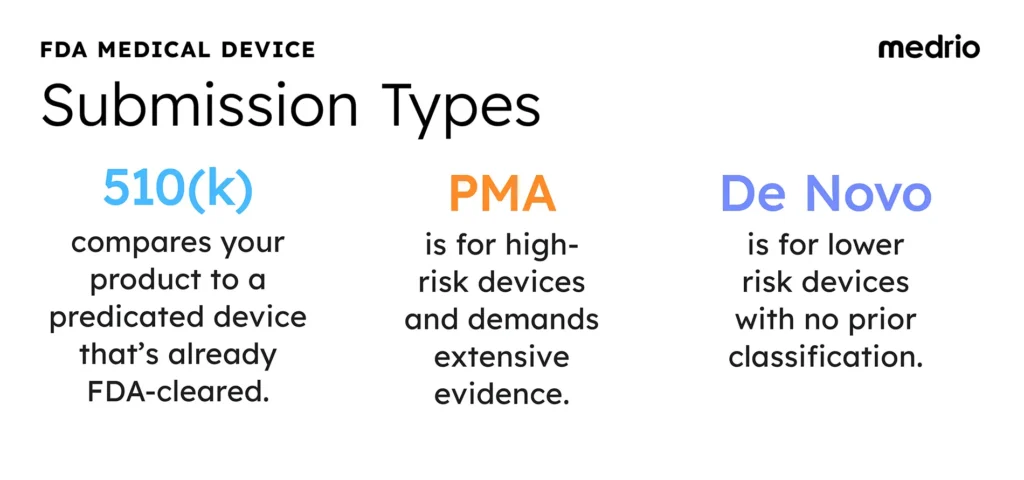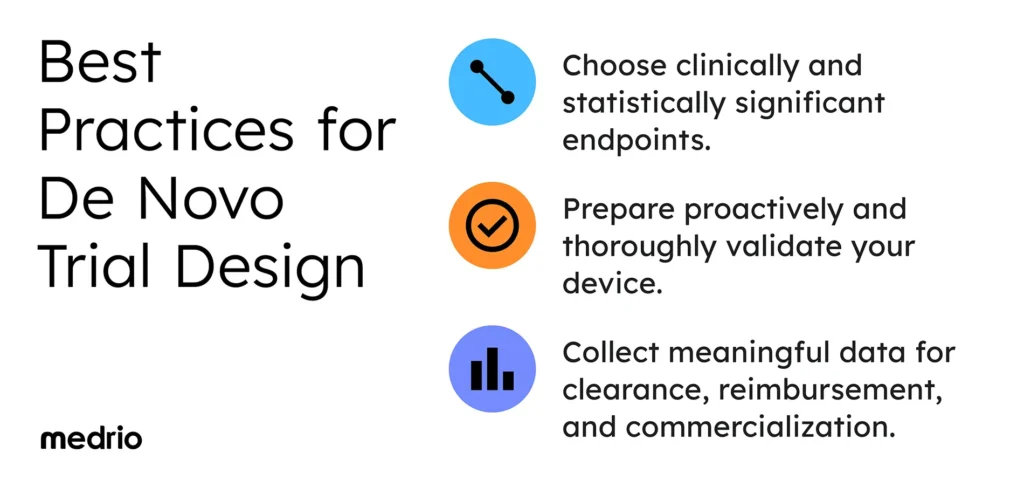Contributing experts: Ellie Reynolds, Director of Regulatory Affairs & Quality Assurance at Proxima CRO, and Tina Caruana, Director of eClinical Solutions at Medrio
Some sponsors choose the FDA De Novo pathway to bring new, low-to-moderate-risk medical devices to market. Often, De Novo submissions require clinical data, and these trials come with different rules, risks, and opportunities than 510(k) or Premarket Approval (PMA) routes.
This guide breaks down the FDA’s De Novo pathway so you can move forward with clarity and confidence.
In this blog post, you’ll learn:
- What qualifies as a De Novo clinical trial?
- How does De Novo differ from 510(k) and PMA?
- What are common misconceptions about De Novo?
- What are the advantages of De Novo classification?
- How can you design a De Novo study for FDA clearance?
- What technology should you consider?
- What technology vendor attributes are important to look for?
What to learn more about De Novo trial success? Hear from your peers in this De Novo podcast episode.
What Is a De Novo Submission?
The De Novo pathway is for devices with no existing equivalent on the market. These are first-of-their-kind innovations.
The FDA created this route to help sponsors avoid the heavier burdens of the Premarket Approval (PMA) process for low- to moderate-risk devices. The De Novo process allows a novel device to be classified as Class I or II, creating a new product category that others can later follow.
Choosing the De Novo pathway may be the right choice if:
- No predicate device exists in the U.S. market
- The device presents low to moderate risk
- The innovation solves a clinical problem in a new way
- No 510(k) route applies
Learn more on the FDA website about De Novo classification requests.
How De Novo Is Different From 510(k) and PMA
Understanding how De Novo compares to 510(k) and PMA helps you determine if it’s the right fit for your device.
The main differences are:
- 510(k) compares your product to a predicated device that’s already FDA-cleared.
- Premarket Approval (PMA) is for high-risk devices and demands extensive evidence.
- De Novo is for devices with lower potential risk and no prior classification.

The main difference lies in classification. 510(k) compares your device to something already cleared, while De Novo establishes a new category. If you’re developing something new but lower-risk, De Novo may be your fastest, cleanest path to market.
Functionally, if a 510(k) submission includes clinical data, it shares important elements with a De Novo submission. Both require strong evidence, clear endpoints, and a well-designed study.
FDA resources for each submission type:
- FDA Premarket Notification 510k (Process, forms, how to, etc.)
- FDA Premarket Approval (PMA) (Process, definitions, application methods, etc.)
- FDA De Novo Classification Request (FAQs, forms, etc.)
Common De Novo Misconceptions
The De Novo pathway has long made early-stage companies and investors uneasy.
Historically, this pathway has been rarely used and poorly understood, seen as a:
- Riskier route compared to the familiar 510(k) process
- Slower process at risk for delays in funding, commercialization, or reimbursement
However, many of these concerns are outdated or overstated. The FDA is now actively encouraging more sponsors to pursue De Novo when no predicate device exists. This recommendation is especially true for innovative products that don’t fit into existing categories.
In fact, if your device would require clinical data for a 510(k), the timelines for De Novo may be comparable. The key is readiness and a proactive, well-prepared strategy.
Companies that approach De Novo with strong data and clear evidence often move through review efficiently.
Learn about how Swing Therapeutics obtained De Novo marketing authorization. Read more here.
Advantages of De Novo Classification
Pursuing a De Novo classification comes with strategic advantages that extend beyond FDA clearance. This approach can lead to a differentiated product and a competitive edge in the market.
Advantages of De Novo include:
- Ability to establish special controls within a new product category: Any future competitors will need to meet the clinical and technical evidence bar you established.
- More flexibility in design: Instead of reverse-engineering a product to match an outdated predicate, you can design a device that solves real problems in the best way possible.
- Justify a smaller or more streamlined study: A streamlined pivotal study can mean faster timelines, lower costs, and less risk.
Designing a De Novo Study
Designing a De Novo trial is similar in many ways to any other FDA-bound clinical study. You still need to run your trial under Good Clinical Practice (GCP).
The main differences are how you choose endpoints and how you’ll use data beyond FDA clearance.

Choose the right endpoints
Choosing the right endpoints is critical. Make your primary endpoint both clinically meaningful and statistically significant. Align endpoints with real-world use and available FDA guidance.
Unlike 510(k), the De Novo process is more self-directed. That means you’ll need to define and justify your endpoints clearly and proactively. Initiate a pre-submission meeting request (pre-sub) to discuss your study design with FDA reviewers.
Since the FDA won’t provide a checklist on how to achieve marketing authorization, you’ll need to bring a solid rationale to the table, especially around safety endpoints.
When selecting endpoints, consider the following:
- Make your primary endpoint clinically meaningful
- Align endpoints with real-world use
- Use available FDA guidance
- Define and justify your endpoints clearly and proactively
- Initiate a pre-submission meeting request with FDA reviewers
Prepare proactively
Small sample sizes are more justifiable in De Novo trials, so early missteps can be harder to overcome. Good preparation can avoid costly delays and do-overs.
One important way to prepare is to thoroughly validate your device, especially any software components, before starting your trial. Otherwise, you may have to redo your trial, which costs both time and money.
Collect meaningful data
Meaningful data is not just about ticking boxes for the FDA—it’s about building the story that will carry your product forward.
When building your data collection plan, consider how to:
- Collect usability and human factor data early
- Track device performance over time
- Gather patient satisfaction and quality of life (QoL) metrics
These data types support future reimbursement and commercialization, not just FDA clearance.
Want to learn more about navigating medical device trials? Download A Medical Device Sponsor’s Guide to Clinical Trials.
Supporting A De Novo Trial With the Right Tech Stack
The data you gather now can set up your product’s future success. But that doesn’t happen if your clinical trial technology is not supportive.
Strong, well-managed data can help you:
- Drive your innovation forward
- Achieve marketing authorization
- Secure funding
- Inform the market
- Establish a regulatory precedent, such as a new device type classification, new predicate device, or special controls
- Educate patients
- Build credibility with payers and partners
- Attain competitive advantage
- Commercialize your product
Tech decisions are always influenced by budget, especially for small companies. Many early sponsors are tempted to go with spreadsheets or paper—or a tool that’s not compliant with regulations.
Choosing compliant, scalable technology from the beginning gives your trial the rigor it needs and the flexibility to grow. A solid technology infrastructure makes your trial data cleaner, submission stronger, and commercialization strategy more effective.
Resources for selecting technology:
- [eBook] What Small Teams Need in a Strategic CDMS/EDC Partner
- [eBook] How to Select the Most Effective RTSM Software
How to Select the Right Vendor for Your De Novo Trial
The right technology partner can make or break your trial. Look for vendors who understand the unique needs of early-stage MedTech sponsors and can scale with you.
Key things to look for in a technology vendor:
- Demonstrated success with MedTech clinical trials
- Strong technology support and onboarding processes
- Platforms with proven regulatory compliance (FDA, EU MDR)
- Cost-effective without sacrificing efficiency or compliance
- Flexible features that allow for quick setup and mid-study adjustments
- Tools that allow autonomous study builds when needed
- Access to responsive experts who can guide setup and strategy
- Real-time data visibility and reporting for informed decision making
Choose a partner who gives you clarity, not confusion—especially when decisions are time-sensitive and high-stakes.
Examples of Medrio De Novo success stories:
- Swing Therapeutics leveraged Medrio CDMS/EDC and eCOA/ePRO for De Novo authorization for the first prescription digital therapy for the treatment of fibromyalgia. | Read the success story.
About Medrio
As an experienced MedTech partner, Medrio understands your research and prioritizes your long-term success. Our technology and experienced team has supported numerous clinical trials leading to FDA De Novo marketing authorization. Our suite of solutions includes CDMS/EDC, eCOA/ePRO, eConsent and RTSM. We’re ready to help you next.
Curious to learn more? Request to talk with Medrio experts.
About Proxima
Proxima Clinical Research, Inc. (Proxima CRO) is a leading Contract Research Organization (CRO) that specializes in providing innovative solutions for medical devices, drugs, and diagnostics across their regulatory, quality, and clinical needs. With a focus on agility and efficiency, Proxima aims to de-risk biotech and MedTech programs, enhance regulatory clearance and approval chances, and optimize capital efficiency. The company is dedicated to supporting clients through every stage of clinical development, ensuring timely and cost-effective results.
Curious to learn more? Learn more about Proxima.



